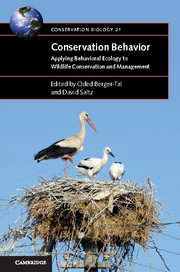Book contents
- Frontmatter
- Dedication
- Contents
- List of contributors
- Prologue
- Preface
- Acknowledgments
- Part I The integration of two disciplines: conservation and behavioral ecology
- Part II Anthropogenic impacts on animal behavior and their implications for conservation and management
- Part III Behavior-based management: using behavioral knowledge to improve conservation and management efforts
- 6 The role of animal sensory perception in behavior-based management
- 7 Behavior-based contributions to reserve design and management
- 8 Behavior-based management: conservation translocations
- 9 From individual behavior to population viability: implications for conservation and management
- 10 Manipulating animal behavior to ensure reintroduction success
- Part IV Behavioral indicators
- Index
- References
6 - The role of animal sensory perception in behavior-based management
from Part III - Behavior-based management: using behavioral knowledge to improve conservation and management efforts
Published online by Cambridge University Press: 05 April 2016
- Frontmatter
- Dedication
- Contents
- List of contributors
- Prologue
- Preface
- Acknowledgments
- Part I The integration of two disciplines: conservation and behavioral ecology
- Part II Anthropogenic impacts on animal behavior and their implications for conservation and management
- Part III Behavior-based management: using behavioral knowledge to improve conservation and management efforts
- 6 The role of animal sensory perception in behavior-based management
- 7 Behavior-based contributions to reserve design and management
- 8 Behavior-based management: conservation translocations
- 9 From individual behavior to population viability: implications for conservation and management
- 10 Manipulating animal behavior to ensure reintroduction success
- Part IV Behavioral indicators
- Index
- References
Summary
INTRODUCTION
At the core of the conservation behavior framework is behavior-based management, which takes into consideration animal behavior in making conservation decisions (Chapter 1). Often, behavior-based management requires manipulation of the behavior of a species in order to accomplish specific conservation or management goals (Sutherland 1998) or avoiding actions producing stimuli that may elicit unwanted behavioral responses. Manipulating behavior may involve repelling an invasive nest parasite from a breeding site, attracting a species to a restored habitat, or sensitizing newly re-introduced individuals to predators. Obviously, the specific means of manipulating behavior will be a function of the biology of the species.
One strategy to modify the behavior of animals is to develop stimuli (visual, auditory, olfactory, etc.) intended to grab their attention and generate a specific type of response. For instance, songs of conspecifics have been used successfully to attract individuals of the endangered Cape Sable seaside sparrow (Ammodramus maritimus mirabilis) to suitable breeding areas in the Florida Everglades (Virzi et al. 2012). But, some situations can be more challenging. For example, in trying to cause aversive responses in rabbits close to agricultural fields, Wilson and McKillop (1986) tested the effectiveness of a commercially available scaring device that would broadcast sounds at high frequencies (9–15 kHz). They found that the device effect was limited to only 3 m and only while it was playing back the sounds, but most importantly animals habituated after just a few days. Despite the different characteristics of the acoustic stimuli and the different taxa, these opposite results suggest that some species may perceive our stimuli, but that perception alone does not guarantee a response. Is there any strategy to increase the success of stimuli developed for conservation or wildlife management purposes?
The first limitation we should acknowledge is that there may be a discrepancy between the perceptual world of the biologists and that of the target species (Lim et al. 2008, Blumstein & Fernández-Juricic 2010). To illustrate this, let us think of the following hypothetical example. Imagine that in a large exhibition tank in an aquarium, we need to attract spotted wobbegong sharks (Orectolobus maculatus) to one part of the tank to feed them and avoid interactions with other species. So, we decide to use yellow LED lights to attract wobbegongs to the feeding portion of the tank, and blue LED lights to discourage them from going to other parts of the tank.
- Type
- Chapter
- Information
- Conservation BehaviorApplying Behavioral Ecology to Wildlife Conservation and Management, pp. 149 - 175Publisher: Cambridge University PressPrint publication year: 2016
References
- 10
- Cited by

